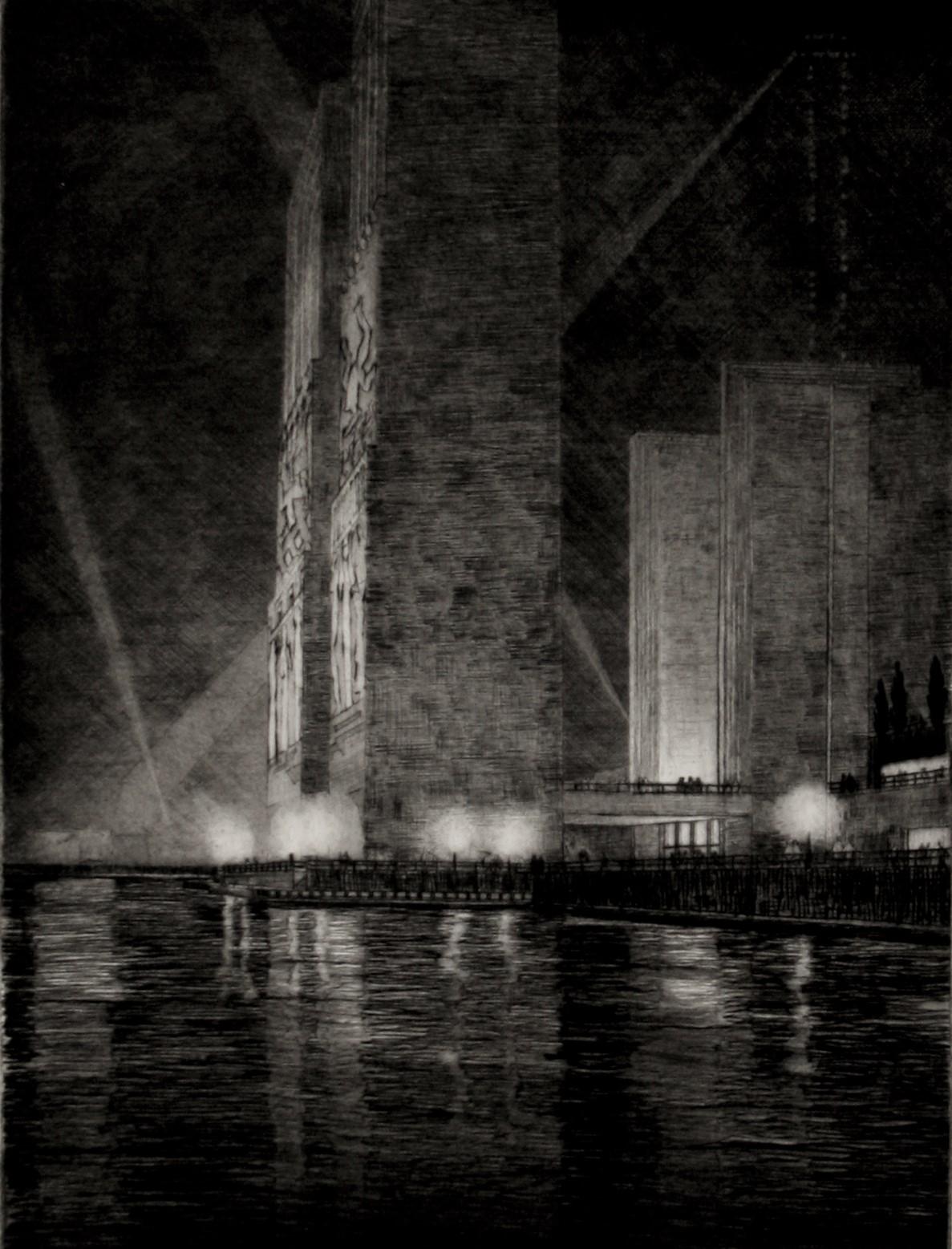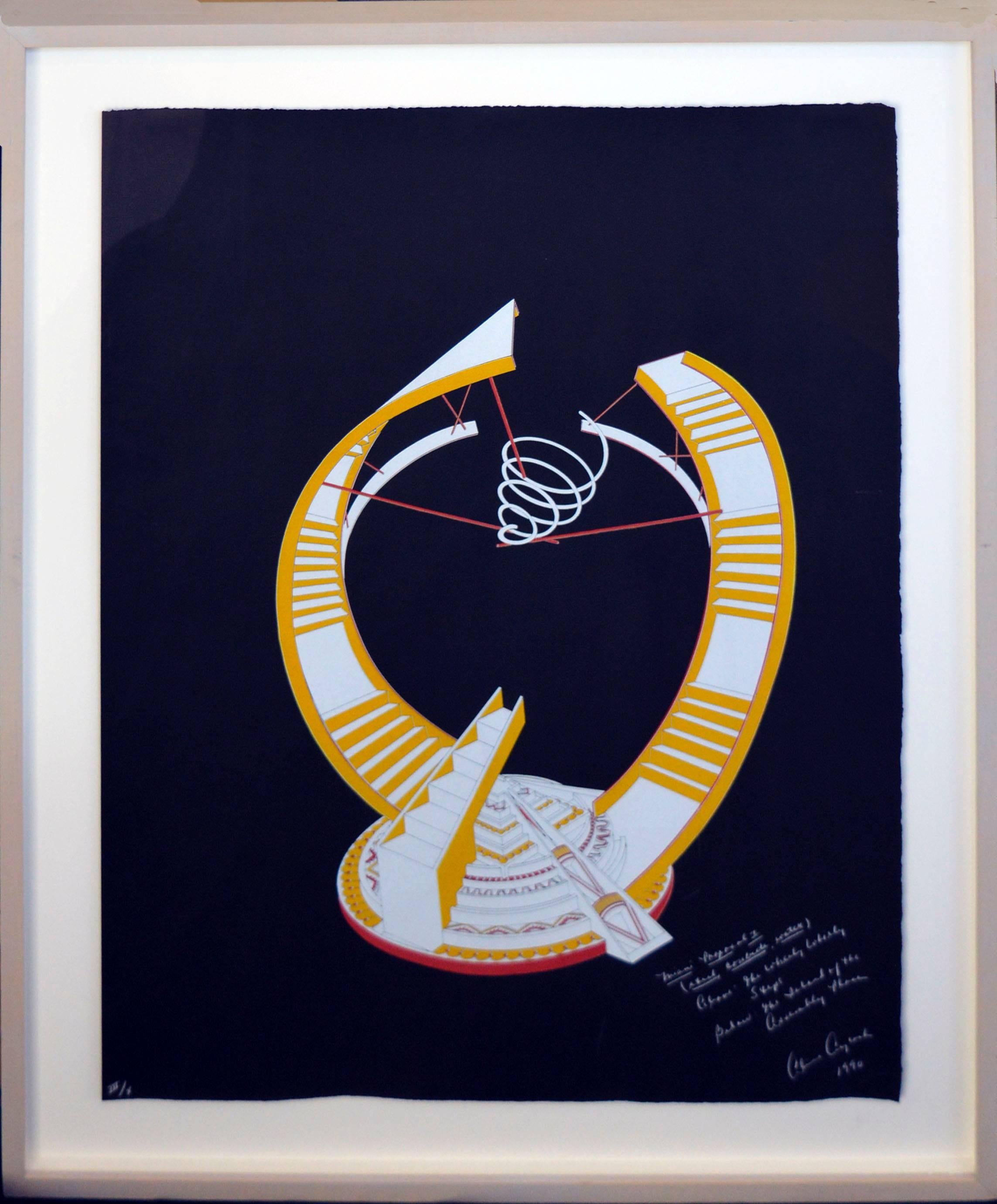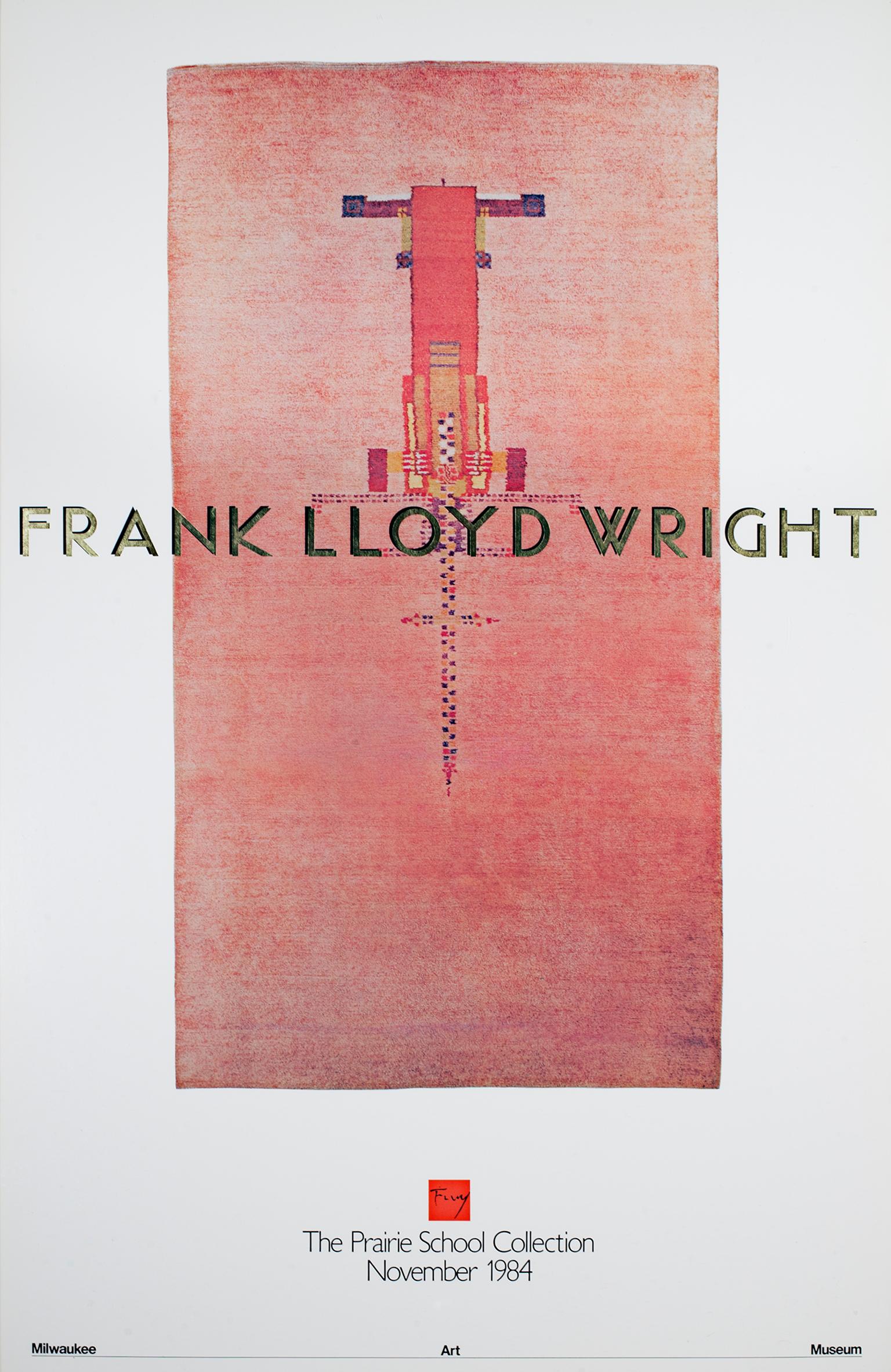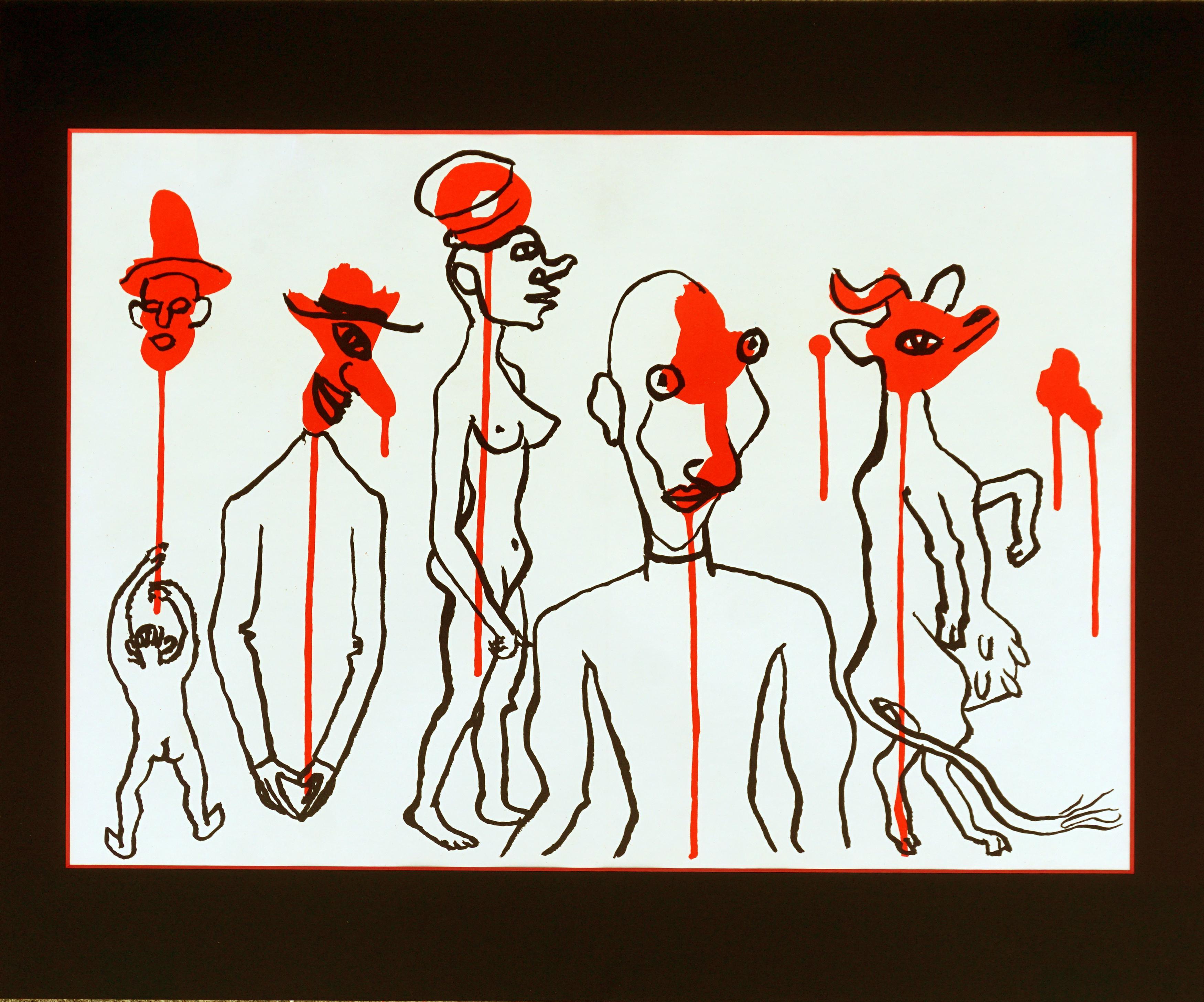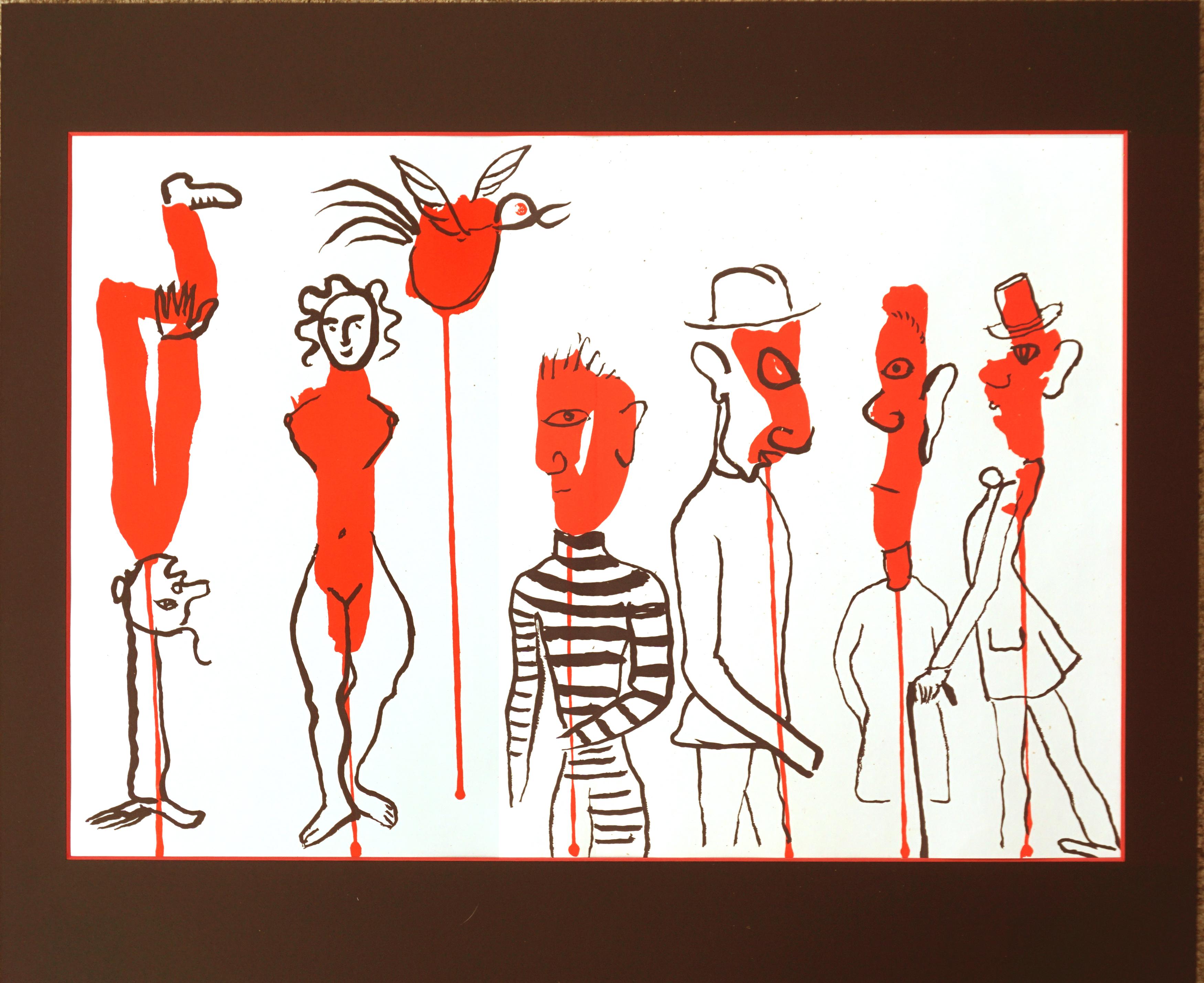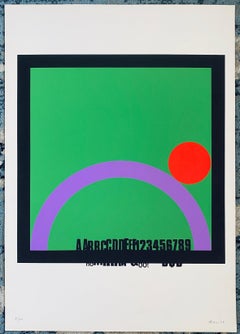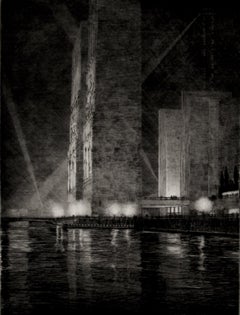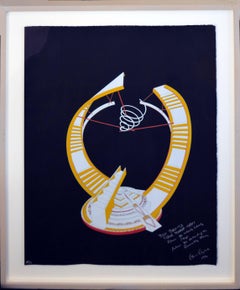
"Jewish Experience in the Art of the Twentieth Century" Vintage Poster
View Similar Items
Want more images or videos?
Request additional images or videos from the seller
1 of 5
Mordecai Ardon"Jewish Experience in the Art of the Twentieth Century" Vintage Poster1976
1976
About the Item
- Creator:Mordecai Ardon (1896 - 1992, Israeli)
- Creation Year:1976
- Dimensions:Height: 28 in (71.12 cm)Width: 21 in (53.34 cm)
- Movement & Style:
- Condition:edge wear with some tears to margins that should mat out or be not visible if linen backed.
- Gallery Location:Surfside, FL
- Reference Number:1stDibs: LU382107492
About the Seller
4.9
Platinum Seller
These expertly vetted sellers are 1stDibs' most experienced sellers and are rated highest by our customers.
Established in 1995
1stDibs seller since 2014
1,539 sales on 1stDibs
Typical response time: 1 hour
More From This SellerView All
- Flight of Sea-Birds: TwilightLocated in Surfside, FLSilkscreen on paper. with some sort of experimental poured stuff on it. there is some loss to the margin but the image is strong. edition 2/6. During the 1930s, Lawrence Edward Kupferman was employed by the WPA Works Progress Administration, making a series of etchings and dry points, mostly of the facades of houses. His style changed completely in the 1940s, becoming first political and expressionist, and later abstract expressionist. He served as chairman of the department of painting at the Massachusetts College of Arts.He studied at the Boston Museum School with Philip Leslie Hale and H. Alden Ripley (1929-1931); Massachusetts School of Art with Ernest L. Majors and Otis Philbrick (1931-1935). Kupferman took motifs from tangible and sensed realities. His atmospheres symbolize cosmic space. Existence is spiritualized as a connected covenant with all of creation. Veil-like, mysterious lines move like vapors over washes of opaque translucent colors that blend, erupt or fade into seas of time-like space and souls become one with an ever-moving, deepening milieu. He admitted, "My figures journey to greet an eternal fellowship with nature’s every particle. . . . "Around 1941, I started to pour paint onto canvases in Provincetown. Jackson Pollock came into my studio to observe how I let paint take on a liquid life or path of its own. Those ethereal poured paintings may have stimulated Pollock's more frantic splashed-on techniques” Kupferman said thoughtfully.Some critics gave him credit for having been one of the pioneering fathers of the poured painting technique. As early as 1943, the Museum of Modern Art, the Whitney Museum of American Art and various publications acknowledged him as a humanistic innovator whose work bluntly exposes humans to themselves. Kupferman, Jack Levine (b. 1915), Hyman Bloom (b. 1913) and David Aronson (b. 1923) founded the "The Boston Urban Jewish School," whose roots ran deep into traditional Hebraic scholarship."Throughout my career," Kupferman admitted, "Boston was a mental and physical prison in which genuineness and spontaneity in art was absent. I summered in Provincetown for artistic sanity. Mark Rothko, Hans Hofmann, Adolph Gottlieb, William Baziotes, Leo Manzu, Byron Brown...Category
20th Century Modern Abstract Prints
MaterialsPaper
- Black SunBy Lawrence KupfermanLocated in Surfside, FLSilkscreen on paper. with some sort of experimental poured stuff on it. there is some loss to the margin but the image is strong. edition 2/6. During the 1930s, Lawrence Edward Kupferman was employed by the WPA Works Progress Administration, making a series of etchings and dry points, mostly of the facades of houses. His style changed completely in the 1940s, becoming first political and expressionist, and later abstract expressionist. He served as chairman of the department of painting at the Massachusetts College of Arts.He studied at the Boston Museum School with Philip Leslie Hale and H. Alden Ripley (1929-1931); Massachusetts School of Art with Ernest L. Majors and Otis Philbrick (1931-1935). Kupferman took motifs from tangible and sensed realities. His atmospheres symbolize cosmic space. Existence is spiritualized as a connected covenant with all of creation. Veil-like, mysterious lines move like vapors over washes of opaque translucent colors that blend, erupt or fade into seas of time-like space and souls become one with an ever-moving, deepening milieu. He admitted, "My figures journey to greet an eternal fellowship with nature’s every particle. . . . "Around 1941, I started to pour paint onto canvases in Provincetown. Jackson Pollock came into my studio to observe how I let paint take on a liquid life or path of its own. Those ethereal poured paintings may have stimulated Pollock's more frantic splashed-on techniques” Kupferman said thoughtfully.Some critics gave him credit for having been one of the pioneering fathers of the poured painting technique. As early as 1943, the Museum of Modern Art, the Whitney Museum of American Art and various publications acknowledged him as a humanistic innovator whose work bluntly exposes humans to themselves. Kupferman, Jack Levine (b. 1915), Hyman Bloom (b. 1913) and David Aronson (b. 1923) founded the "The Boston Urban Jewish School," whose roots ran deep into traditional Hebraic scholarship."Throughout my career," Kupferman admitted, "Boston was a mental and physical prison in which genuineness and spontaneity in art was absent. I summered in Provincetown for artistic sanity. Mark Rothko, Hans Hofmann, Adolph Gottlieb, William Baziotes, Leo Manzu, Byron Brown...Category
20th Century Modern Abstract Prints
MaterialsPaper
- Italian Artist Modern Silkscreen Eugenio CarmiBy Eugenio CarmiLocated in Surfside, FLEugenio Carmi is an Italian painter born in 1920 in Genoa. He studied in Turin in Felice Casorati’s studio. His experience as a graphic designer in the ‘50s, is decisive for his pictorial research, based on a rigorous geometrical structure and on a fine analysis of the perception of colors. He participated in the Venice Biennale in 1966. In 1967 he showed some electronic works in the Superlund exhibition organized by Pierre Restany in Lund, Sweden. In 1968, he introduced the “Carm-o-matic”, during the Cybernetic Serendipity show at the Institute of Contemporary Art in London. In 1973, he produced an entirely abstract 25-minute show for RAI’s Experimental Programs Service. The same year, he taught visual art seminars at the Rhode Island Institute of Design in the United States. In the ‘70s, he gave courses at the Accademia of Macerata and at the Accademia of Ravenna (Italy). He produced illustrations for three of Umberto Eco’s stories, published in Italy by Bompiani and in many other countries. The French Ministry of Education has selected them for libraries and schools in France. The most important retrospective of his work was organized by the Milan town hall in 1990, followed by a prestigious exhibition in Budapest, in the halls of the Royal Palace, in 1992. In 1991 he exhibited at the San Francisco Italian American Museum. In 1996 the “Carmi” book is published by Umberto Eco and Duncan Macmillan and presented at the Milan Triennial: a synthesis of his life. From 1957 to 1965 he will play the role of artistic director of Cornigliano's corporate magazine. During this time iron and steel are materials that Carmi meets every day and become a strong creative stimulus for him. In his first solo exhibition - presented by Gillo Dorfles in 1958 at the Galleria Numero di Firenze - the protagonists are the enamels on steel and since 1960 he made various iron and steel works welded and lithographed milk. Iron and steel is the work that in 1962 presented at Spoleto Sculpture exhibition in the city , organized by Giovanni Carandente under the V Festival of the Two Worlds . In this period, he is involved not only in the cultural politics of the Istallier ( Victor Vasarely , Umberto Eco , Max Bill , Konrad Wachsmann , Furio Colombo , Ugo Mulas , Kurt Blum , Emanuele Luzzati , Flavio Costantini ) , But also in the cultural activity of the Warehouse Gallery , which Carmi founded in Boccadasse in 1963. The Warehouse Gallery with multiples intends to propose a serial art accessible to a wider audience and is placed in international discussions on 'Multiplied Art, representing one of the most important examples. The friendship and mutual esteem that binds him to Umberto Eco has two very important fruits at this time: Children's Fables and Stripsody . In 1966 for the publishing house Bompiani came three Eco fables illustrated by Carmi and then re-introduced in 1988 with new Carmi illustrations and a fable more. Stripsody is a musical project on cartoon sound, designed and then interpreted by the genius singer Cathy Berberian, with Eco texts and illustrations by Carmi. Eugenio Carmi, who is always fascinated by the new technological possibilities in the 1960s and 1970s, is the author of experimental cinematic and audiovisual artwork and also realizes those who will call electrical imagery signals that will also be at the center of a provocative installation on the streets of the city of Caorle . It is at this stage that in 1966 he was at the XXXIII edition of the Venice Biennale with the electronic work SPCE (electronically controlled polycyclic structure), which is also the invitation of Pierre Restany to participate with electronic works at the SuperLund exhibition in Sweden. In 1971, he moved to Milan with his family, where he established his study. At this point, though with incursions in other parallel fields such as the realization of mirrors and stained glass, painting, and sporadically sculpture - which had approached the Istal period - is at the center of its activity. It is at the beginning of the seventies that it deepens the geometric language, already open with some previous experiences (accident prevention signs for the Italsider, some multiples for the Deposit and electrical imagery signals), replacing it with the informal one. In 1979 he produced a magazine - which will remain the same number - by the name of Res Publica , for which he receives the contributions of intellectuals and artists, including Umberto Eco, Antonio Porta , Gillo Dorfles , Richard Paul Lohse...Category
1980s Modern Abstract Prints
MaterialsScreen
- DADA Artist Abstract Figures Silkscreen Lithograph Print Israeli ModernistBy Marcel JancoLocated in Surfside, FLMarcel Janco, was a Romanian and Israeli visual artist, architect and art theorist. He was the co-inventor of Dadaism and a leading exponent of Constructivism in Eastern Europe. In...Category
20th Century Modern Abstract Prints
MaterialsScreen, Lithograph
- Henry Moore 1973 Lithograph edition 28/75 Sculpture Figures Reclining NudesBy Henry MooreLocated in Surfside, FLHenry Spencer Moore (1898 – 1986) Moore was born in Castleford, the son of a coal miner. He became well-known through his carved marble and larger-scale abstract cast bronze sculptures, and was instrumental in introducing a particular form of modernism to the United Kingdom later endowing the Henry Moore Foundation, which continues to support education and promotion of the arts. After the Great War, Moore received an ex-serviceman's grant to continue his education and in 1919 he became a student at the Leeds School of Art (now Leeds College of Art), which set up a sculpture studio especially for him. At the college, he met Barbara Hepworth, a fellow student who would also become a well-known British sculptor, and began a friendship and gentle professional rivalry that lasted for many years. In Leeds, Moore also had access to the modernist works in the collection of Sir Michael Sadler, the University Vice-Chancellor, which had a pronounced effect on his development. In 1921, Moore won a scholarship to study at the Royal College of Art in London, along with Hepworth and other Yorkshire contemporaries. While in London, Moore extended his knowledge of primitive art and sculpture, studying the ethnographic collections at the Victoria and Albert Museum and the British Museum. Moore's familiarity with primitivism and the influence of sculptors such as Constantin Brâncuși, Jacob Epstein, Henri Gaudier-Brzeska and Frank Dobson led him to the method of direct carving, in which imperfections in the material and marks left by tools became part of the finished sculpture. After Moore married, the couple moved to a studio in Hampstead at 11a Parkhill Road NW3, joining a small colony of avant-garde artists who were taking root there. Shortly afterward, Hepworth and her second husband Ben Nicholson moved into a studio around the corner from Moore, while Naum Gabo, Roland Penrose, Cecil Stephenson and the art critic Herbert Read also lived in the area (Read referred to the area as "a nest of gentle artists"). This led to a rapid cross-fertilization of ideas that Read would publicise, helping to raise Moore's public profile. The area was also a stopping-off point for many refugee artists, architects and designers from continental Europe en route to America—some of whom would later commission works from Moore. In 1932, after six year's teaching at the Royal College, Moore took up a post as the Head of the Department of Sculpture at the Chelsea School of Art. Artistically, Moore, Hepworth and other members of The Seven and Five Society would develop steadily more abstract work, partly influenced by their frequent trips to Paris and their contact with leading progressive artists, notably Pablo Picasso, Georges Braque, Jean Arp and Alberto Giacometti. Moore flirted with Surrealism, joining Paul Nash's modern art movement "Unit One", in 1933. In 1934, Moore visited Spain; he visited the cave of Altamira (which he described as the "Royal Academy of Cave Painting"), Madrid, Toledo and Pamplona. Moore made his first visit to America when a retrospective exhibition of his work opened at the Museum of Modern Art in New York City.[28] Before the war, Moore had been approached by educator Henry Morris, who was trying to reform education with his concept of the Village College. Morris had engaged Walter Gropius as the architect for his second village college at Impington near Cambridge, and he wanted Moore to design a major public sculpture for the site. In the 1950s, Moore began to receive increasingly significant commissions. He exhibited Reclining Figure: Festival at the Festival of Britain in 1951, and in 1958 produced a large marble reclining figure for the UNESCO building in Paris. With many more public works of art, the scale of Moore's sculptures grew significantly and he started to employ an increasing number of assistants to work with him at Much Hadham, including Anthony Caro and Richard Wentworth. Moore produced at least three significant examples of architectural sculpture during his career. In 1928, despite his own self-described extreme reservations, he accepted his first public commission for West Wind for the London Underground Building at 55 Broadway in London, joining the company of Jacob Epstein and Eric Gill..At an introductory speech in New York City for an exhibition of one of the finest modernist sculptors, Alberto Giacometti, Sartre spoke of The beginning and the end of history...Category
1970s Modern Abstract Prints
MaterialsLithograph
- Austrian Sound Space Architect Bernhard Leitner Photo Lithograph Hand Signed ArtLocated in Surfside, FLBernhard Leitner, (Austrian, 1938) From a portfolio "Sound : Space" "Ton : Raum" Self published by artist in 1975/1976, Limited edition of 50 Hand signed in pencil by artist. Acc...Category
1970s Modern Abstract Prints
MaterialsScreen
You May Also Like
- Grand Canal, America (Electrical Buildings at Night)By Gerald GeerlingsLocated in Storrs, CTCzestochowski 31. 11 3/4 x 8 7/8 (sheet 12 x 18). Edition 100. Presentation print for the Chicago Society of'Chicago Fair 1933. A rich impression with t...Category
Mid-20th Century American Modern Landscape Prints
MaterialsAcrylic, Drypoint
- Vintage Silkscreen Abstract -- The Wheely Whirly StepsBy Alice AycockLocated in Soquel, CAExpressive vintage silkscreen on black paper by Alice Aycock (American, 20th Century). Hand signed and dated "Alice Aycock 1990" with hand written ...Category
1990s American Modern Abstract Prints
MaterialsScreen, Laid Paper
- "The Prairie School Collection - Rug" Offset Lithograph Poster with Gold FoilBy (after) Frank Lloyd WrightLocated in Milwaukee, WI"The Prairie School Collection - Rug" is an offset lithograph poster with gold foil. This piece advertises an exhibition of Frank Lloyd Wright's designs. 34 7/8" x 22" art 36" x 23...Category
1980s American Modern Abstract Prints
MaterialsLithograph
- Leo Baeck "and a Spirit is Characterized"By Corita KentLocated in Missouri, MOLeo Baeck and a Spirit is Characterized Sister Mary Corita Kent (American, 1918-1986) Signed Lower Right in Pencil Edition of 250 Lower center 21.5 x 21.5 inches 24 x 24 inches frame...Category
20th Century American Modern Abstract Prints
MaterialsColor, Lithograph
Price Upon Request - Alexander Calder Mid Century Derrière le Miroir LithographBy Alexander CalderLocated in Soquel, CAVintage 1960s Alexander Calder Lithograph double page part of portfolio "Derriere le Miroir". Published by: Galerie Maeght, Paris, 1966. No. 156. Text on verso. Unsigned, from an unknown edition. Presented in black mat with red core. Mat size: 20"H x 24"W. Image size: 15"H x 22"W. American artist Alexander Calder changed the course of modern art by developing an innovative method of sculpting, bending, and twisting wire to create three-dimensional “drawings in space.” Resonating with the Futurists and Constructivists, as well as the language of early nonobjective painting, Calder’s mobiles (a term coined by Marcel Duchamp in 1931 to describe his work) consist of abstract shapes made of industrial materials––often poetic and gracefully formed and at times boldly colored––that hang in an uncanny, perfect balance. His complex assemblage Cirque Calder (1926–31), which allowed for the artist’s manipulation of its various characters presented before an audience, predated Performance Art by some 40 years. Later in his career, Calder devoted himself to making outdoor monumental sculptures...Category
1960s Modern Figurative Prints
MaterialsPaper, Ink
- Alexander Calder Mid Century Derrière le Miroir LithographBy Alexander CalderLocated in Soquel, CAVintage 1960s Alexander Calder Lithograph double page part of portfolio "Derriere le Miroir". Published by: Galerie Maeght, Paris, 1966. No. 156. Text on verso. Unsigned from an unknown edition. Presented in black mat with red core. Mat size: 20"H x 24"W. Image size: 15"H x 22"W. American artist Alexander Calder changed the course of modern art by developing an innovative method of sculpting, bending, and twisting wire to create three-dimensional “drawings in space.” Resonating with the Futurists and Constructivists, as well as the language of early nonobjective painting, Calder’s mobiles (a term coined by Marcel Duchamp in 1931 to describe his work) consist of abstract shapes made of industrial materials––often poetic and gracefully formed and at times boldly colored––that hang in an uncanny, perfect balance. His complex assemblage Cirque Calder (1926–31), which allowed for the artist’s manipulation of its various characters presented before an audience, predated Performance Art by some 40 years. Later in his career, Calder devoted himself to making outdoor monumental sculptures...Category
1960s Modern Figurative Prints
MaterialsPaper, Ink
